How to define a cryptocurrency bear market? Are we in a crypto bear market now?
Are we in a crypto bear market now? How to define a cryptocurrency bear market? Is the cryptocurrency bear market coming?

Macro headwinds and deteriorating market sentiment have put the crypto market on the brink of a bear market. Both the BTC and COIN50 index fell below the 200-day moving average, VC financing was weak, and the market value evaporated by 40%. This report analyzes key cycle indicators, determines whether it has entered a new round of encrypted winter, and provides tactical response suggestions.
The BTC and COIN50 indexes have both fallen below their respective 200-day moving averages recently, sending signals of a potential crypto bear market.
- The overall crypto market value outside BTC fell 41% from its peak of $1.6 trillion in December 2024, and fell to $950 billion as of mid-April, and VC financing fell 50-60% from its peak in 2021-22;
- Given the current situation, we believe that a defensive risk strategy should be adopted, although we expect crypto prices to bottom out in the mid-to-late second quarter of 2025 to create conditions for the recovery in the third quarter.
The intersection of multiple signals may indicate the beginning of a new round of "encrypted winter". The escalation of global trade tariffs and a sharp deterioration of sentiment have become the main reasons. The current total market value of the crypto market except BTC has fallen to $950 billion, down 41% from its December 2024 high of $1.6 trillion and 17% lower than the same period last year. Historically, the current market value is even lower than most of the time periods from August 2021 to April 2022.
Meanwhile, although VC financing in the first quarter of 2025 rebounded from the previous quarter, it was still 50-60% lower than the 2021-22 cycle peak level. This greatly limits the entry of new capital, especially in the altcoin field. The above structural pressure comes from uncertainty in the macro environment - traditional risky assets are subject to fiscal tightening and tariff policies, resulting in investment decisions stagnation. As the stock market is set, even if the crypto industry enjoys positive regulatory trends, it will not hide the difficulties of its recovery.
Various factors are intertwined to depict a difficult cyclical outlook in the digital asset field, and caution still needs to be maintained in the short term (or in the next 4-6 weeks). However, we believe investors should adopt a tactical response strategy, and once sentiment is reset and the rebound may appear quickly, we still maintain constructive expectations for the second half of 2025.
The definition of a bull market and a bear market
A common criterion for traditional stock markets to define bull and bear markets is the 20% rise and fall from recent highs or lows. However, this standard is slightly arbitrary and has poor applicability in crypto markets with extremely high volatility. Cryptocurrencies such as Bitcoin often fluctuate by 20% in the short term, which does not necessarily mean that the market structure has really changed. For example, historical data shows that Bitcoin fell 20% in a week and is still likely to be in a long-term uptrend, and vice versa.
Furthermore, crypto markets are traded around the clock, so when traditional markets close (such as night and weekends) tend to act as an alternative indicator of global risk sentiment, amplifying their price response to external events. For example, during the Fed's aggressive rate hike cycle (January to November 2022), the S&P 500 fell 22%, while the Bitcoin price fell 76% since November 2021, a drop of nearly 3.5 times that of the stock market.
What is a bear market?
The bear market is characterized by lack of confidence, oversupply and falling prices. Therefore, investors who are pessimistic about rising asset prices and do not have high expectations are called shorts. For investors just starting out, understanding the complexity of a bear market can be a difficult task. Since a rebound is often a gradual and unpredictable process, affected by various external factors such as global economy, regulations and general investor perceptions, it is difficult to predict when a bear market will reach its lowest price. assets.
However, they can open up new options. Additionally, if you have a long-term investment plan, buying in a downturn may lead to substantial profits when the cycle turns. Investors who only focus on short-term should pay attention to the fluctuations in asset prices temporarily. Experienced investors may be ahead and resort to short selling, including betting on a decline in asset value. The dollar cost average is another strategy used by many cryptocurrency investors. By spreading risks, you can invest in bull and bear markets.
The impact of a bear market
In crypto markets, it is important to be able to determine whether the market is bearish or bullish from the investor's perspective. We will discuss the impact of a bear market on cryptocurrencies, covering the following aspects:
-Supply and Demand - Although in bearish markets, investors tend to seek to sell their assets, this doesn't seem feasible because demand is relatively low compared to supply. This leads to deterioration in asset prices.
- Market Performance - Bearish market means that investors are reluctant to trade their crypto assets due to unreliable economic performance.
-Investor Outlook - Since a very critical part of crypto trading is the investor's psychology, negative intuitions may force investors to sell their assets due to low confidence. This will not only lead to further price declines, but will also prompt other investors in the market to do the same.
- Crypto Price - Bearish markets usually mean that the price of crypto assets falls.
-Liquidity - Bearish markets reduce asset liquidity due to relatively low levels of investor confidence.
The truth in contradiction
The primary observation about the "20% bull and bear dividing line" in the stock market is that this standard has never been unifiedly recognized, and it is more like a rule of thumb. As Justice of the Supreme Court, Porter Stewart, said: "I can't explain it clearly, but I know it when I see it." The identification of market trends often depends on intuition and experience rather than rigid formulas.

Nevertheless, for formal measures, we analyzed the closing price of the S&P 500 for a rolling year to determine the main timing of the reversal. Over the past decade, the indicator shows that U.S. stocks have experienced about four bull markets and two bear markets—excluding the latest pullback from late March to early April (our model has also begun to signal bear markets recently). See Figure 1.
However, the standard ignores at least two important 10-20% retracements, such as the surge in volatility caused by late 2015 (China's stock market fluctuations) and 2018 (surge in global trade uncertainty). See Figure 2.
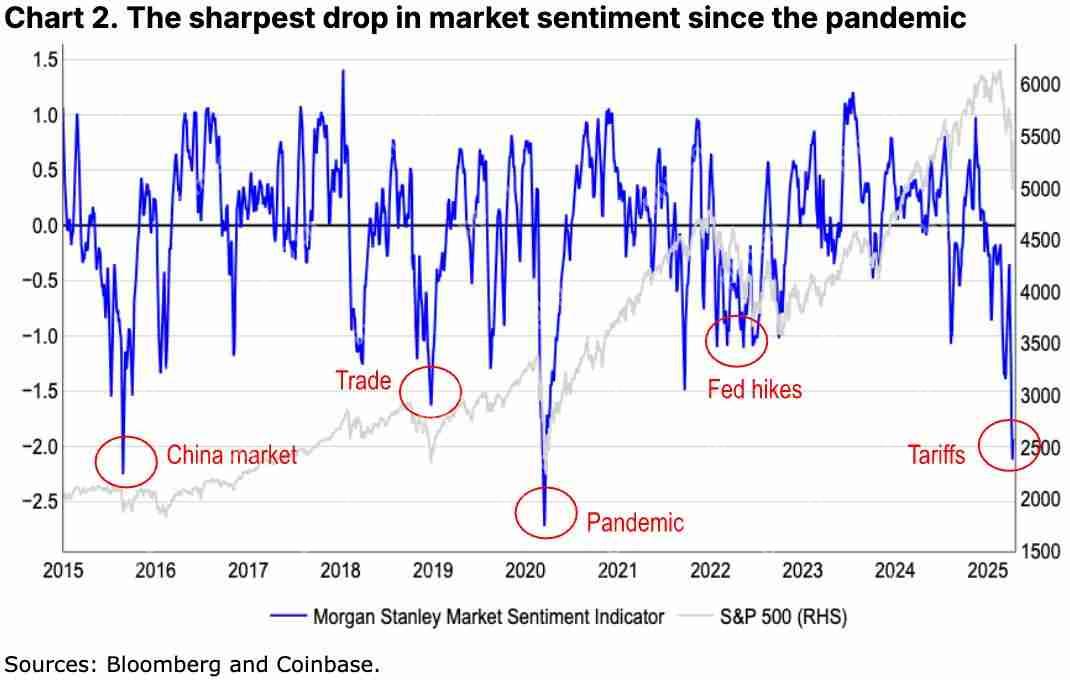
We have seen in the past that despite the declines not reaching the traditional 20% threshold, sentiment-driven market declines still often trigger defensive adjustments in portfolios. In other words, we believe that a bear market essentially represents a “regimal shift” in market structure—characterized by deterioration in fundamentals and liquidity contractions—and should not be defined by percentage declines alone.
In addition, the "20% rule" may cause investors to take it lightly and ignore some important warning signals, such as market depth shrinkage and defensive sector rotation, which have often appeared before significant declines in history.
Alternative indicators
Therefore, we are more inclined to find indicators that better capture the subtle interaction between price and investor psychology—applicable to stocks and crypto assets. The bear market is essentially a cycle of "returns" and also reflects the continuous deterioration of "emotion", because emotions are the main reason behind the long-term decline that investors are most reluctant to face. The understanding of this concept is quite subtle - the "reversal" we seek may not all be a continuous manifestation of long-term trends. The COVID-19 epidemic is a classic case of a rapid rebound after a short-term sharp decline. Of course, its transientity is largely the result of a rapid and powerful response to global fiscal and monetary policy - otherwise investors may face a longer-term drawdown period.
Therefore, instead of relying on rules of thumb, we tend to focus on the following metrics:
- risk-adjusted performance (measured by standard deviation);
- 200-day moving average (200d MA).
For example, from November 2021 to November 2022, Bitcoin fell 1.4 standard deviations (z-score) relative to its previous 365 days, while the standard deviation of the stock market fell 1.3 during the same period. This shows that from the perspective of risk adjustment, Bitcoin's 76% decline is comparable to the S&P 500's 22% decline after volatility adjustment.
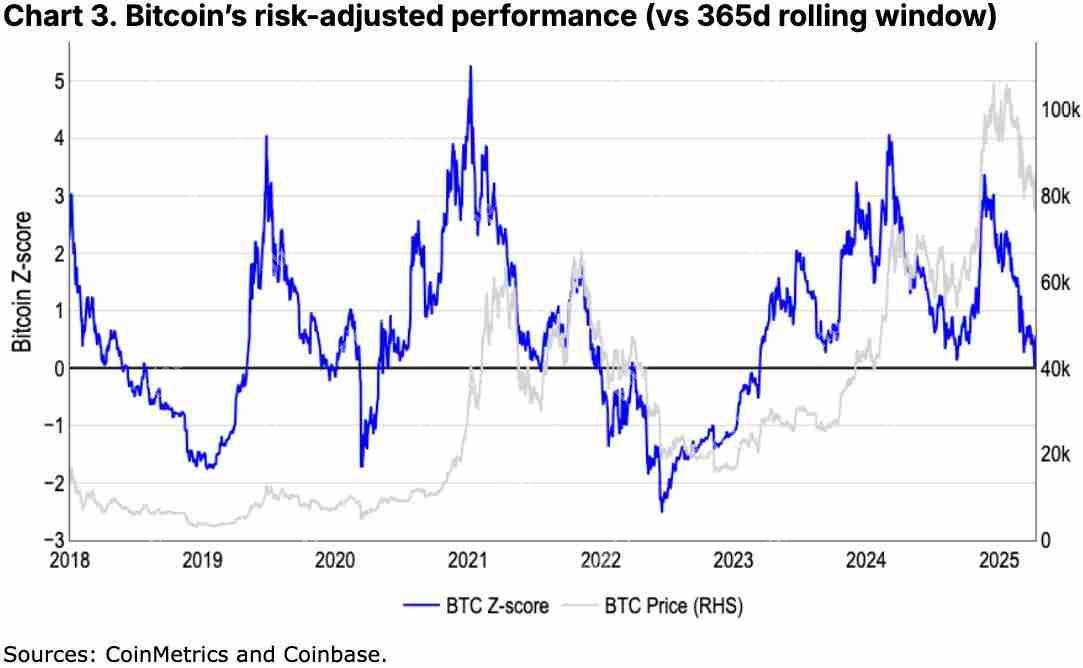
Since this indicator naturally takes into account the higher volatility of the crypto market, z-score is very suitable for trend analysis of crypto assets, but it also has certain limitations: not only is the calculation relatively complex, but it also sends fewer signals when the market is relatively stable, and its response to trend changes is relatively lagging. For example, our model shows that the most recent bull cycle ended at the end of February this year, but subsequent market activities are classified as “neutral”, highlighting the possible lag of this approach in rapidly changing markets.
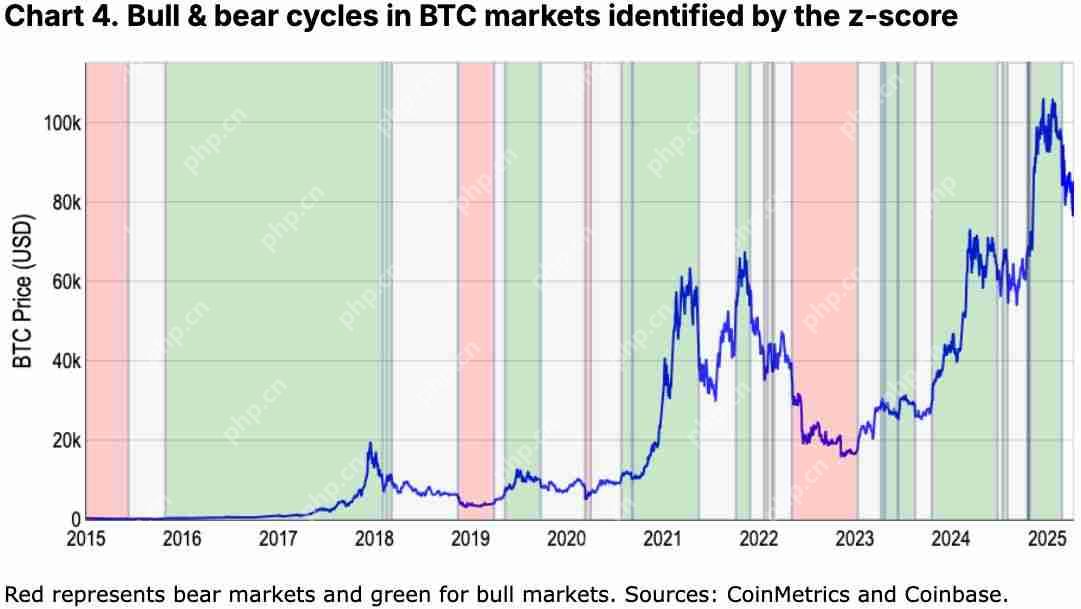
In contrast, we believe that the 200-day moving average provides a cleaner and more reliable way to identify sustained market trends. Since it takes at least 200 days of data to calculate, it can effectively filter short-term noise and dynamically adjust as prices change, presenting a clearer picture of momentum trends. The logic of judgment is also very intuitive:
- If the price continues to be higher than the 200-day moving average and accompanied by rising momentum, it is a bull market;
- If the price continues to fall below the 200-day moving average and is accompanied by the decline momentum, it is a bear market.
In our opinion, this approach not only is basically consistent with the trend signals given by the "20% rule" and the z-score model, but also provides more operational insights in a rapidly changing market environment. For example, the 200DMA model not only captures the market pullback during the COVID-19 pandemic (early 2020) and the Federal Reserve's interest rate hike cycle (2022-23), but also effectively identifies the market decline caused by China's ban on crypto mining in mid-2021. In addition, we found that this indicator can better correspond to the large fluctuations in investor sentiment in different periods (see Figure 5 and Figure 6).
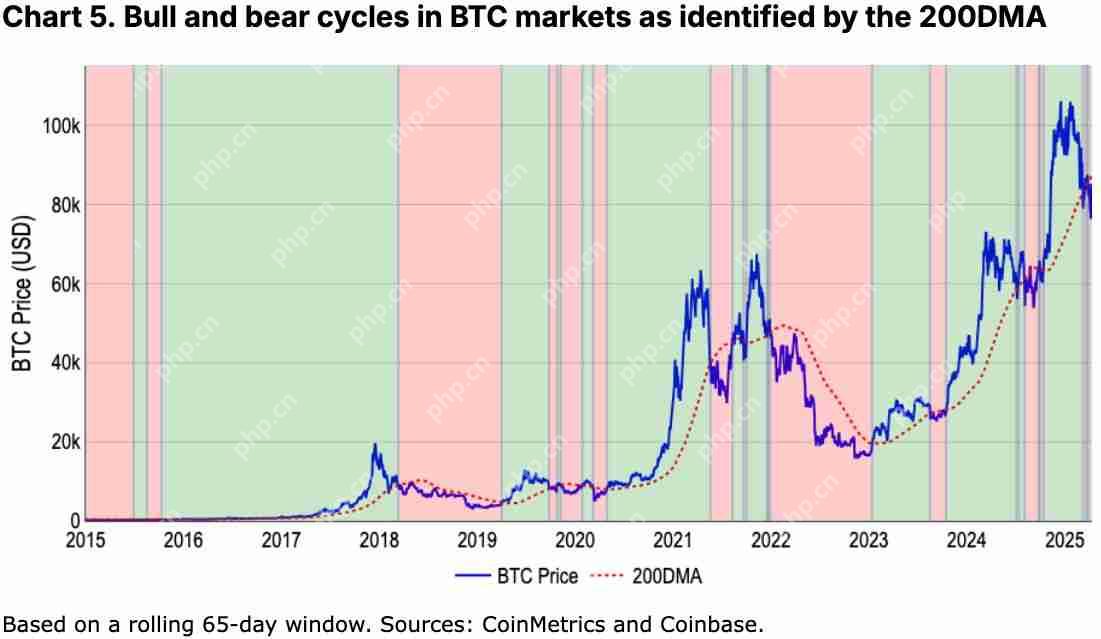
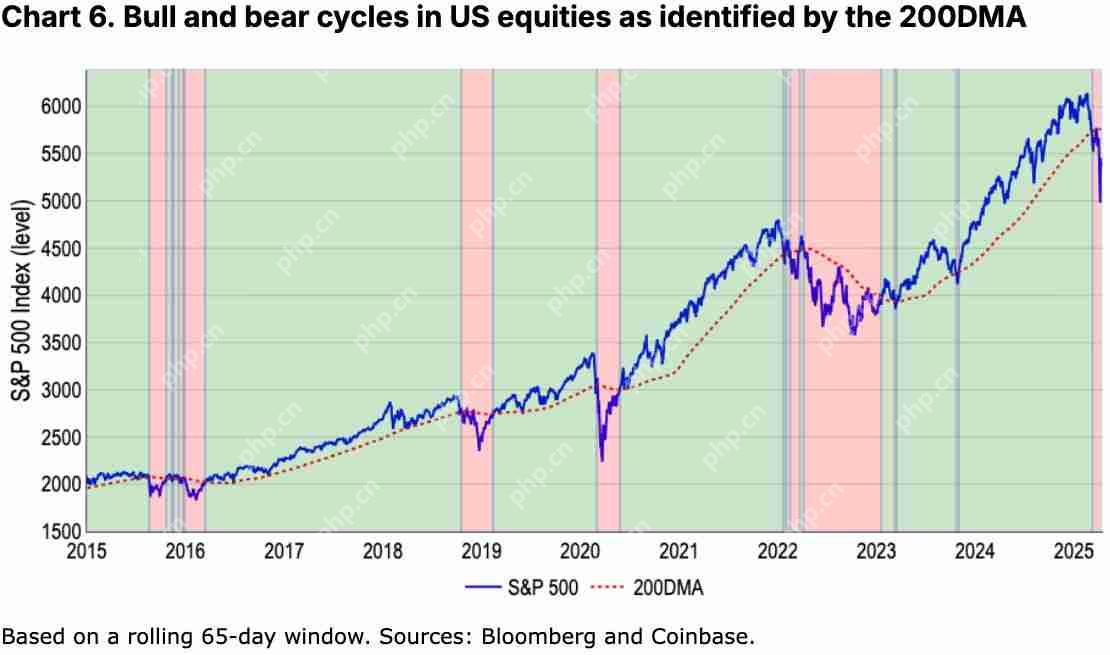
Encrypted winter?
So, are we in a crypto bear market now? As of now, our main focus of analysis is on Bitcoin, because its historical data can be compared with traditional markets such as US stocks. However, although Bitcoin is often regarded as a representative of the performance of the crypto market, its role as a market benchmark is increasingly weak as the asset class expands into new areas such as memecoin, DeFi, DePIN, and AI Agent.
For example, the Bitcoin-based 200DMA model shows that the currency's recent sharp decline is in line with a new bear market cycle starting in late March. However, if the same model is applied to the COIN50 index (including the top 50 tokens in market cap), it shows that the asset class has been clearly in the bear market since the end of February. This is also consistent with the difference between the overall crypto market capitalization (excluding BTC) falling 41% from its December 2024 high, while Bitcoin has fallen less than 20%, highlighting the high volatility and risk premium of altcoin at the end of the risk curve.

Should you invest in a bear market?
To determine whether and how much to invest in a bear market, the usual rules still apply, but you need to follow a stricter risk aversion strategy to ensure you get a return on your assets. Market leaders like Bitcoin or Ethereum are often a great choice for investing during a bear market; while it may be difficult to get them like other currencies, you get them for less money and they are most likely to appreciate quickly when the market rebounds. Crypto traders often buy during bear markets to profit from lower crypto prices. Therefore, when optimistic markets emerge, they are more likely to make substantial profits. Similar to any other trading strategy, this involves risk. Therefore, it is crucial to understand past trends and keep abreast of crypto news.
Other cryptocurrencies may seem like a good option during market crises, but they usually have returns that are delayed until non-existent and may not be a good investment. Do your research carefully before investing in any cryptocurrency.
How should you invest in a bear market?
Given the price drop and investors have little confidence in cryptocurrencies, investing during bear markets is inherently risky. However, this risk may lead to greater future returns. So you might buy cryptocurrencies for less money and then sell them at the peak of the next bull market. Investors can also sell their current assets as early as possible when they find a decline and then buy back at a lower price when the market falls further. As a variety of situations can lead to bear markets, their duration is relatively difficult to predict. The problem is that no one knows exactly how long or how long the price cut will last, so you risk buying or missing out on valuable options on the verge of buying.
Investors can use various strategies to profit from and survive volatile crypto markets. Whether there is a long-term crypto winter or not, investors can use these strategies to manage their overall risks and portfolio more effectively. We will now discuss in detail from the perspective of investors what to do in a bear market.
Utilize strategic investment strategies
Investors can use various technologies to purchase assets step by step and in small quantities; the most important of them is the US dollar cost average technology. This method reduces the impact of price changes caused by volatility through average prices. While this approach may eventually help investors connect with businesses with good fundamentals, delaying until the beginning of the integration phase can also be beneficial. DCA investors should prioritize initiatives involving communities, sustained development and a reliable roadmap that articulates their long-term goals.
Short cryptocurrency
Short selling of Bitcoin is to buy it back at a lower cost in the future. The goal is to make a purchase when the expected price drops. Because the opportunity to profit from a cryptocurrency decline is proportional to the risk of losing money, short selling may be a viable strategy. Be careful when deciding how and where to short the crypto market. When it comes to short circuits, timing is essential. Spend some time learning more detailed short circuit techniques and how to determine whether they are beneficial or harmful.
Diversified portfolio
Financial experts recommend diversifying the portfolio to ensure that not all assets are cryptocurrencies during market downturns. If one component of the portfolio performs poorly, the likelihood of a serious disaster is reduced. Cryptocurrency investors may diversify their holdings by finding new investment projects and focusing on currencies with a good track record. It is useful to view crypto projects that are currently in their early stages. DAO is a newer project that allows anyone to fully participate in the creation and financial success of the project. Before developing a cryptocurrency bear market strategy, due diligence and thorough investigation of the business must be conducted.
Try encrypted stake
Staking is a simple strategy that can boost portfolio value over the entire cryptocurrency bear market in the long term. Staking further helps reduce the trend of worrying about regular price changes. When investors focus on market trends, they face the risk of making emotional judgments. Pledging coins may allow you to earn extra cash as investors wait for the market to turn during a crypto bear market. Native tokens can be pledged on multiple Layer 1 protocol networks in exchange for profit.
Keep discipline when trading
Many people now trade short-term. Trading can be done at the best price by increasing the stop loss level. In a bear market, it is also essential to accept returns before finding what can change your life. It is best to accept a fixed meager income. There will still be profits regardless of whether a significant increase or decrease. Relying solely on speculative-based prices is dangerous because they are often unsustainable.
Make sure to grasp your emotions firmly
Many investors have experienced ups and downs due to the cryptocurrency market downturn. It is easy to make potentially dangerous emotional judgments when things keep changing. When bear markets appear before cryptocurrency winter, investor sentiment can be very turbulent. Investors must always be cautious because fear and ambition can lead to bad decisions. By combining smart DCA and diversification strategies, traders can help prevent emotional decisions that may hurt them.
Summarize
As Bitcoin’s “store of value” role becomes increasingly stronger, we believe that the cyclical characteristics of the crypto market need to be evaluated from a more holistic perspective in the future, especially in the context of the ever-diversification of its fields. Despite this, both the BTC and COIN50 index fell below the 200-day moving average, sending a signal that the overall market has weakened for a long time. This is in line with the shrinking overall market value and the shrinking VC financing, and may indicate the arrival of an encrypted winter.
Therefore, we believe that defensive risk strategies should be adopted at present, although we still believe that crypto market prices may stabilize in the middle and late period of the second quarter of 2025, thus providing the basis for a recovery in the third quarter. At this stage, the challenges brought by the macro environment require investors to remain more alert.
The above is the detailed content of How to define a cryptocurrency bear market? Are we in a crypto bear market now?. For more information, please follow other related articles on the PHP Chinese website!

Hot AI Tools

Undresser.AI Undress
AI-powered app for creating realistic nude photos

AI Clothes Remover
Online AI tool for removing clothes from photos.

Undress AI Tool
Undress images for free

Clothoff.io
AI clothes remover

Video Face Swap
Swap faces in any video effortlessly with our completely free AI face swap tool!

Hot Article

Hot Tools

Notepad++7.3.1
Easy-to-use and free code editor

SublimeText3 Chinese version
Chinese version, very easy to use

Zend Studio 13.0.1
Powerful PHP integrated development environment

Dreamweaver CS6
Visual web development tools

SublimeText3 Mac version
God-level code editing software (SublimeText3)

Hot Topics
 1672
1672
 14
14
 1428
1428
 52
52
 1332
1332
 25
25
 1277
1277
 29
29
 1257
1257
 24
24
 What is Solayer(LAYER)? Solayer Token Economics and Price Forecast
May 14, 2025 pm 10:06 PM
What is Solayer(LAYER)? Solayer Token Economics and Price Forecast
May 14, 2025 pm 10:06 PM
Introduction Decentralized Finance (DeFi) is changing the way users interact with blockchain technology, creating seamless and flexible ways for transactions, lending and earnings creation. Solayer (LAYER) is at the heart of this change, building a protocol that connects liquidity and practicality across multiple blockchains. With the popularity of DeFi and the growing demand for efficient cross-chain infrastructure, Solayer is attracting the attention of traders, developers and investors who are looking for the next major opportunity. This article will explain the concept of Solayer, detail its innovative features and token economics, and look forward to its 2030
 One article to clarify the role of stablecoins during economic fluctuations
May 14, 2025 pm 09:15 PM
One article to clarify the role of stablecoins during economic fluctuations
May 14, 2025 pm 09:15 PM
You don't need to be an economist to feel the economic turmoil. Prices fall, job stability declines, and everyone seems to be anxious about their financial future. What is a stablecoin? Stablecoins are like life jackets in the crypto world: a digital currency designed to keep its value stable, often linked to stable assets such as the US dollar or gold. Unlike cryptocurrencies with severe price fluctuations such as Bitcoin or Ethereum, stablecoins pursue stability. When an economic storm strikes, investors will naturally seek stability, and stablecoins just provide this safe-haven asset – free from volatility. Why stablecoins thrive when economic instability is
 XDC and XRP: Which one is more attractive to investment?
May 14, 2025 pm 10:09 PM
XDC and XRP: Which one is more attractive to investment?
May 14, 2025 pm 10:09 PM
The two tokens are highlighted by their different use cases and technical characteristics, namely XDC and XRP. Both are in compliance with ISO20022 standards, meaning they comply with global financial messaging standards for seamless interoperability. However, their purpose, market, and the technology differences behind them are significant. In this article, we will compare XDC and XRP in detail to explore their strengths, weaknesses, market potential, and investment considerations in depth. XDC and XRP: Which one is more attractive to investment? Both XDC and XRP are decentralized tokens, but they target different industries and take a unique approach. Here are them
 What are the cryptocurrency arbitrage strategies? Four common arbitrage strategies and risk analysis
May 14, 2025 pm 09:18 PM
What are the cryptocurrency arbitrage strategies? Four common arbitrage strategies and risk analysis
May 14, 2025 pm 09:18 PM
The English name of cryptocurrency arbitrage is CryptoArbitrage, which refers to a strategy of trading on two exchanges at the same time and making profits by locking the spread on both sides. Cryptocurrency investment has large fluctuations and high risks. Investors want to find strategies that can reduce risks and make profits. Cryptocurrency arbitrage is one of the types of strategies, but is arbitrage strategies really necessarily low risk? What is cryptocurrency arbitrage? When there are different quotes for the same cryptocurrency pair, buy low and sell high at the same time, and use risk-free or extremely low risk to earn the profits of the spread, which is the arbitrage transaction conducted by cryptocurrency arbitrage in the cryptocurrency field, which generally refers to buying and selling on different exchanges.
 What is the future of VINU coins? VINU coin price analysis and investment strategy in 2025
May 14, 2025 pm 09:30 PM
What is the future of VINU coins? VINU coin price analysis and investment strategy in 2025
May 14, 2025 pm 09:30 PM
Table of Contents What is VitaInu (VINU)? What is VINU token? 2025 VINU Coin Price Forecast VitaInu (VINU) Price Forecast 2025-2030 to 2030 VitaInu (VINU) Price Forecast 2025 VitaInu Price Forecast 2026 VitaInu Price Forecast 2027 VitaInu Price Forecast 2028 VitaInu Price Forecast 2029 VitaInu Price Forecast 2030 VitaInu Price Forecast Interpretation of VINU’s Market Performance
 What should I do if I don't get the account after the recharge of Huobi Huobi? Solution to the recharge of Huobi
May 14, 2025 pm 08:42 PM
What should I do if I don't get the account after the recharge of Huobi Huobi? Solution to the recharge of Huobi
May 14, 2025 pm 08:42 PM
When you recharge on Huobi Huobi platform, if you find that the funds have not arrived, this may cause you to be anxious and confused. Fortunately, there are some specific steps and methods to help you solve this problem. The following are detailed solutions and operating guides to help you quickly find solutions when you encounter the problem of recharge not being received.
 The best currency trading platform recommended by the top ten currency exchange platforms
May 14, 2025 pm 09:36 PM
The best currency trading platform recommended by the top ten currency exchange platforms
May 14, 2025 pm 09:36 PM
Best currency trading platform: 1. Binance is the world's largest exchange, providing diversified financial products. 2. Ouyi is known for its powerful derivative trading functions. 3.Gate.io provides a wide range of currency options. 4. Huobi is famous for its stable system and diverse financial products. All platforms support fiat currency transactions, have a user-friendly interface, and provide mobile applications and multiple payment methods.
 Introduction to Cryptocurrency Investment: What are currency standard contracts and U standard contracts? How to use it?
May 14, 2025 pm 09:42 PM
Introduction to Cryptocurrency Investment: What are currency standard contracts and U standard contracts? How to use it?
May 14, 2025 pm 09:42 PM
With the rapid development of the digital currency market, cryptocurrency derivatives trading has attracted increasing attention from investors. Among many trading tools, contract trading has become a trading method favored by many investors due to its leveraged trading characteristics and high risk and high returns. However, for beginners, the concepts of coin-prime contracts and U-prime contracts are often confusing. This article will analyze the characteristics, differences and their application in cryptocurrency investment in detail. What is a currency standard contract? A currency standard contract is a derivative contract that uses cryptocurrencies as margin and settlement currency. In this model, investors use Bitcoin or other cryptocurrencies as collateral to trade



